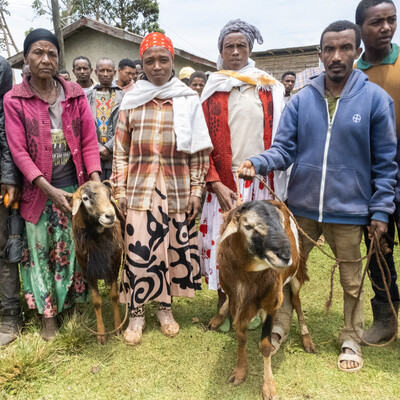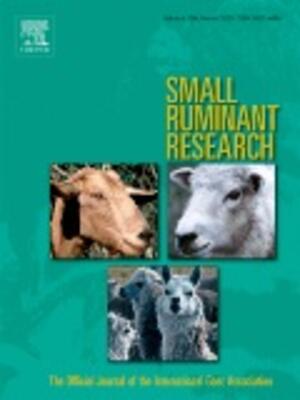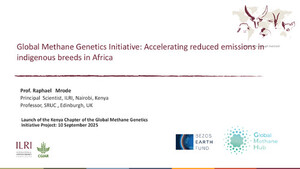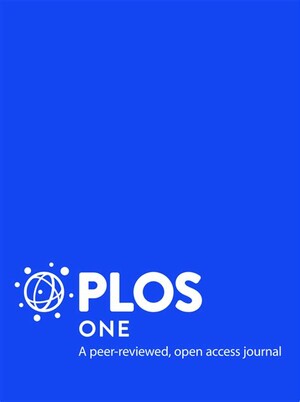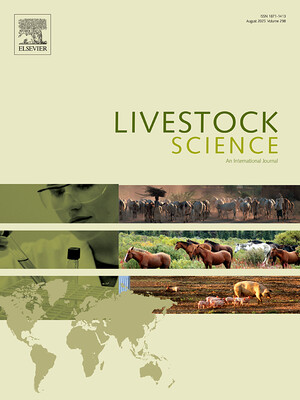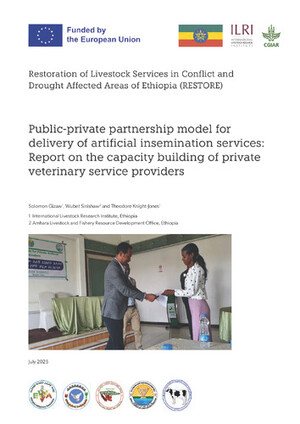
ILRI’s Kapiti livestock research station—and Kenyan and global public goods—imperiled by land grabs in Kenya
Over the past several weeks,
illegal attempts to grab land
have escalated at Kapiti Plains Estate
(now known as Kapiti research station),
located about 60 km southeast
of Nairobi along Mombasa Road,
in Kenya’s Machakos County.
Members of groups involved in the
illegal sales have started trespassing
and building illegal structures
on Kapiti research station.
No land at Kapiti is for sale.

Who owns Kapiti?
Kapiti has been wholly owned, managed and operated by the International Livestock Research Institute (ILRI) for three decades. ILRI is a not-for-profit international research centre headquartered in Kenya. It is a member of the CGIAR system of 15 global agricultural research centres and their partners conducting research for a food-secure future. For several decades, ILRI has been working closely with national governments and ministries in conducting research to improve the livelihoods and lives of small-scale livestock keepers in Africa and Asia.

What is Kapiti used for?
Kapiti is an ILRI research station located on 32,000 acres of semi-arid rangeland in southeastern Kenya. Kapiti land and facilities are operated solely for public good research; this is not a commercial ranch and ILRI makes no profit from it.
The 80 ILRI staff working at Kapiti maintain for research purposes about 2,500 head of Kenya’s native and popular Boran beef cattle, 1,200 native Kenyan red Maasai and exotic Dorper sheep, and 250 Galla goats, which are native to northern Kenya.
The different breeds and types of livestock are kept at Kapiti to conduct research on animal health and productivity for the benefit of millions of farmers, herders and pastoralists in Kenya and across Africa and Asia.

As one of the few as yet unfragmented rangelands in the region, Kapiti also is a safe haven for large numbers of wildlife. Serving as a critical wildlife corridor for migratory mammals, Kapiti helps to maintain the fragile and unique Athi-Kapiti-Kaputei ecosystem of Kenya’s Southern Conservancy Area, with the internationally acclaimed Nairobi National Park being a centrepiece of this ecosystem.1 This park’s wildlife regularly disperses throughout the ecosystem, with more wildlife on any given day found on pastoral grazing land outside the park. Indeed, some 12,000 head of wild mammals were counted on ILRI’s Kapiti research station in a recent aerial survey—many more wildlife than were in the park itself at that time.
The main reason for ILRI’s acquisition of Kapiti was to produce ‘clean’ (disease-free) animals for controlled livestock vaccine trials. Most of East Africa’s ruminant livestock are raised on tropical drylands. Because the number of animals needed for vaccine trials is large and the number of animals that drylands such as Kapiti can support (called a ‘stocking rate’ or ‘carrying capacity’) is low, large tracts of land are required for this kind of animal health research. Kapiti’s size is in line with that of other drylands research stations, such as Kenya’s Kiboko Research Station, which is larger than Kapiti.
Kapiti is essentially a living laboratory for studying and improving livestock production in Africa’s tropical drylands. It’s a place where ILRI and its Kenyan and other research partners can develop better breeds and feeds and find new ways to treat devastating animal diseases in the confidence that what works at Kapiti will work for millions of livestock keepers tending animals in similar environments.
After ILRI bought Kapiti in the 1980s, most of the animals raised there were used in intensive, long-term research to develop vaccines against tropical livestock diseases. Later, innovative livestock genetics and breeding work was added to this animal health research. Over the last 15 years or so, research at Kapiti has continued to expand in both volume and scope and now includes livestock feeding trials and environmental assessments of African livestock production systems. The latter investigations are determining the first-ever reliable estimations of greenhouse gas emissions from African livestock and ways for livestock keepers to better cope with, and mitigate, climate change.

How is Kapiti benefiting Kenyans?
Kenya’s livestock sector is primed for growth. Demand for meat and milk is rising rapidly in Kenya and is estimated to nearly double by mid-century. The livestock sector today contributes more than 40% to Kenya’s agricultural gross domestic product, at a total value of KES515 billion, and employs 50% of the country’s agricultural labour force.

But because climate change is expected to make much of Kenya’s climate drier and harsher in years to come, it is critical that Kenya, some 83% of which consists of arid and semi-arid lands, prepares itself with research that reveals new ‘climate-smart’ approaches for using its extensive dryland pastoral grazing systems to support livestock-dependent communities. Kapiti is serving as a major centre for this type of research.

Smallholder Kenyan dairy incomes: Past work at Kapiti Research Station helped increase incomes for Kenya’s small-scale milk producers, processors and sellers and now generates KES3.3 billion in related benefits to Kenya annually as well as providing thousands of jobs for Kenyan youth and labourers.

Vaccines for Kenyan livestock: The research by local and international scientists also contributed to development, production and dissemination of a widely used and highly effective vaccine against East Coast fever in cattle, which kills an unvaccinated African animal every 30 seconds. Today, researchers at Kapiti are conducting safety trials of vaccines against other animal diseases such as Rift Valley fever, which is vital for both livestock and the 50 million East Africans also threatened by this disease; the last outbreak of Rift Valley fever in Kenya, in 2006–7, killed more than 100 people and cost the country KES3.1 billion. The researchers are also testing a promising new vaccine against malignant catarrhal fever, a herpes virus occurring in Kenya’s Kapiti and Masai Mara regions that is transmitted from wildebeest to sheep and cattle grazing locations where wildebeest have recently calved, depositing the virus. The experimental vaccine, based on a viral isolate from Kenya, induced immunity in 80 per cent of animals vaccinated at Kapiti in 2016; data from further studies at Kapiti will support the commercialization of this vaccine.
The 2011 eradication from the world of rinderpest, a cattle plague that has devastated the economies of whole regions, is an example of just how important animal health research is to reducing the huge burden livestock diseases continue to place on Kenya and other tropical developing countries. With the last reported outbreak of rinderpest anywhere in the world occurring in Kenya’s Meru National Park in 2001, the Africa Union-InterAfrican Bureau for Animal Resources estimates the total benefits of eradicating rinderpest from Kenya to be KES44.7 billion.

Kenyan livestock breed improvements: Having recently discovered that a Kenyan Boran animal is resistant to East Coast fever, ILRI researchers are working to ensure the selection of that desirable trait in the country’s Boran breeding programs. And the researchers are working with local communities to cross-breed high-yielding exotic Dorper sheep with drought- and disease-resistant local red Maasai sheep2 to help Kenyan farmers deal with climate change.

Kenyan livestock-wildlife ecosystems: The traditional co-existence of livestock and wildlife at Kapiti has also enabled ILRI scientists working closely for many years with a local Maasai community at Kitengela, in neighbouring Kajiado County, to find ways to reduce wildlife-human conflicts and to increase the benefits wildlife provide livestock herders. Besides wildlife tourism, such benefits include an ambitious Wildlife Conservation Lease program paying pastoral land owners not to fence, develop or sell their land. The latter program depended on the work of a highly participatory ILRI-led research project improving livestock production in the Kitengela region and producing maps showing which lands were fenced and which remained open, maps that were subsequently used by the local Maasai council to develop a ‘master land-use plan’ for better managing this region’s unique land, livestock and wildlife resources.3, 4, 5

Livestock insurance for Kenyan pastoralists: Among many other research projects benefiting Kenya and Kenyans directly, ILRI has been pioneering jointly with the Government of Kenya and its ministries innovative insurance schemes protecting poor pastoralists in northern Kenya against livestock losses due to drought. A recently initiated government-run Kenya Livestock Insurance Program based on ILRI’s pilot insurance project has so far paid out about KES547 million to over 20,000 pastoralists in the region.6

Kenyan livestock and climate change: Researchers are also using Kapiti to determine the greenhouse gas emissions generated by Kenyan livestock. This, the first study of its kind conducted anywhere in Africa, found African cattle are less responsible for some forms of global warming than previously believed.7 ILRI researchers at Kapiti are also testing new ways to feed and manage African livestock that can both increase livestock and farm yields and reduce livestock impacts on the environment.

Just who and what is the land grabbing putting at risk?
As to who, and what, is most at risk from the land grabbing at Kapiti, which has been escalating since November 2017, consider the following.
First are the people of Machakos County and elsewhere in Kenya who have been duped into thinking this land is available for purchase and stand to lose substantial amounts of money.
Second are the 80 ILRI workers who live with their families at Kapiti and the Kenyan and international scientists who conduct their experiments at Kapiti, many of whom have now been threatened with violence by the trespassers.
Third, these illegal incursions also threaten the wildlife-rich Athi-Kapiti Plains ecosystem, which is essential to the health of Nairobi National Park and other pre-eminent conservation areas in southern Kenya.
And fourth, the ongoing lawlessness risks disrupting or stopping important long-term livestock research, thereby threatening the futures of hundreds of millions of livestock producers—as well as the processors, sellers and consumers of milk and meat—across Kenya, Africa and Asia.
In brief, Kenyan people and livestock-wildlife ecosystems, as well as critical livestock research for the poor, are all now imperilled by the greedy actions of a few.

Footnotes
1 ‘Livestock and a large number of wild herbivores dominate the Kitengela ecosystem, with wildebeest and zebra constituting over half the total wildlife population. Other wildlife species include: Maasai giraffe, Coke’s hartebeest, black rhino, African buffalo, Grant’s gazelle, Thomson’s gazelle, eland, impala and waterbuck and predators such as lions, cheetahs and leopards as well as a high diversity of bird life. The ecosystem forms an important part of the wet season dispersal area for wildlife that lives part of the year in Nairobi National Park.’
—From Valuing alternative land-use options in the Kitengela wildlife dispersal area of Kenya: A joint International Livestock Research Institute (ILRI) and the African Conservation Centre (ACC) report undertaken for the Kitengela community, by Patti Kristjanson, Maren Radeny, David Nkedianye, Russ Kruska, Robin Reid, Helen Gichohi, Fred Atieno and Robert Sanford, ILRI Impact Assessment Series, ILRI, 2002.
2 ‘Red Maasai sheep is a fat-tailed indigenous sheep breed in Kenya. It is renowned for its resistance to . . . gastrointestinal parasites and drought tolerance. It is, however, poorly ranked in terms of body weight. Until the mid-1970s, purebred Red Maasai sheep was the main type of sheep kept in the southern pastoral lands of Kenya, probably numbering several million head. In the 1970s, however, a population of the synthetic meat breed Dorper was imported to Kenya from South Africa for research and multiplication purposes, to increase weight gain. No instruction was provided to farmers about how to maintain a continuous crossbreeding programme and many farmers continued crossing their flocks with Dorpers. This indiscriminate crossbreeding was subsequently proven unsuitable in many production areas. Crossbreeding or upgrading to Dorper may be appropriate if the environmental conditions are good. In semi-arid regions, and when there is adequate feed, Dorper sheep has a larger body size and produces well compared with Red Maasai. However, in more harsh conditions, for example in arid or humid areas or under high parasite challenge, Red Maasai are of about the same size as Dorper and survive better . . . . Farmers . . . show interest in both breeds: Red Maasai for its drought and disease tolerance and Dorper for its body size and growth, so in order for a breeding programme to be accepted, it should consider using both breeds.
— From Purebreeding of Red Maasai and crossbreeding with Dorper sheep in different environments in Kenya, Journal of Animal Breeding and Genetics, by E Zonabend König, E Strandberg, JMK Ojango, T Mirkena, AM Okeyo and J Philipsson, Dec 2017.
3 See Participatory mapping helps community save wildlife-rich pastoral lands, Geneflow Magazine, 2006, and Can the lion lie down with the lamb?, Msafiri Magazine, 2004.
4 Between 1977 and 2002, the wildlife populations in the plains to the south of Nairobi National Park fell by over 70%. Particularly hard hit were migratory animals such as wildebeest, which traditionally graze in the national park during the dry season and move south in search of new pasture during the wet season. From nearly 40,000 migrating animals in the 1970s, wildebeest numbers have fallen to about 1000 [in 2012]. . . . This is one of the few places in the world where you can see major wildlife populations, including 24 species of large mammals, grazing and hunting against the jagged backdrop of a populous city, often in the company of Maasai cattle. Little wonder, then, that there are conflicts between conservation and development, and sometimes between wildlife and the Maasai. . . . [T]he master plan provides the local council, for the first time, with the means to control development.—From Saving the plains: ILRI research team wins Sustainability Science Award for its pastoral research in Masailand, ILRI News blog, Jun 2012.
5 Read the award-winning science paper: ‘Evolution of models to support community and policy action with science: Balancing pastoral livelihoods and wildlife conservation in savannas of East Africa’, by R S Reid, D Nkedianye, M Y Said, D Kaelo, M Neselle, O Makui, L Onetu, S Kiruswa, N Ole Kamuaroa, P Kristjanson, J Ogutu, S B BurnSilver, M J Golman, R B Boone, K A Galvin, N M Dickson, Proceedings of the National Academy of Sciences, 3 Nov 2009.
6 For more about ILRI’s Index-Based Livestock Insurance (IBLI) project and the Kenya Government’s Kenya Livestock Insurance Programme (KLIP), visit the IBLI website and read: Record payouts being made by Kenya Government and insurers to protect herders facing historic drought, ILRI News blog, 21 Feb 2017.
7 Go here to read more about the impacts of climate change in Kenya and ILRI’s work to estimate greenhouse gas emission levels from African livestock.

Where can I get more information?
- ILRI brief about Kapiti Plains farmhouse and research centre: http://hdl.handle.net/10568/81323
- ILRI in Kenya brief: http://hdl.handle.net/10568
- ILRI website www.ilri.org and news blog news.ilri.org
- CGIAR website: www.cgiar.org
- ILRI projections of Kenya’s livestock trends: www.slideshare.net/ILRI/kenya-livprojections-timmar2015
- ILRI Corporate Report 2006: Safeguarding Livestock Diversity: The Time Is Now: http://hdl.handle.net/10568/2479
- ILRI Corporate Report 2015–2016: http://hdl.handle.net/10568/78805
- ILRI Strategy 2013–2022: Brochure http://hdl.handle.net/10568/29037
Who can I contact for further information?
For ILRI matters
Jimmy Smith, ILRI director general: j.smith [at] cgiar.org
Dieter Schillinger, ILRI assistant director general for biosciences: d.schillinger [at] cgiar.org
Romano Kiome, chief of party of a collaborative, ILRI-led agricultural development project in Kenya: r.kiome [at] cgiar.org
For technical or legal matters
Linda Opati, ILRI legal counsel: l.opati [at] cgiar.org
Ilona Gluecks, ILRI research facilities manager (on 3 weeks leave abroad starting 18 December 2017): i.gluecks [at] cgiar.org
For media enquiries
Susan MacMillan, ILRI communications, awareness, advocacy: s.macmillan [at] cgiar.org, cell: 0725 473 248







